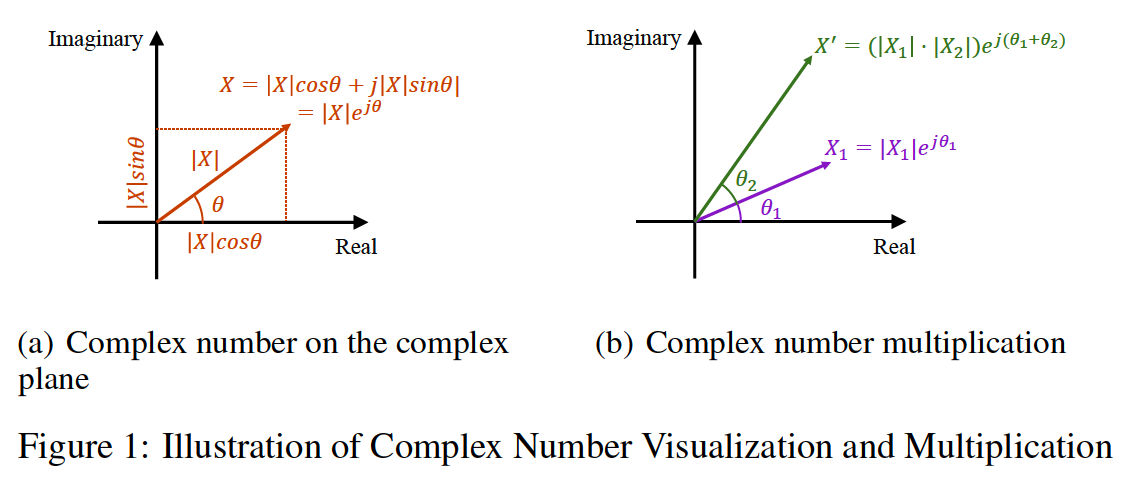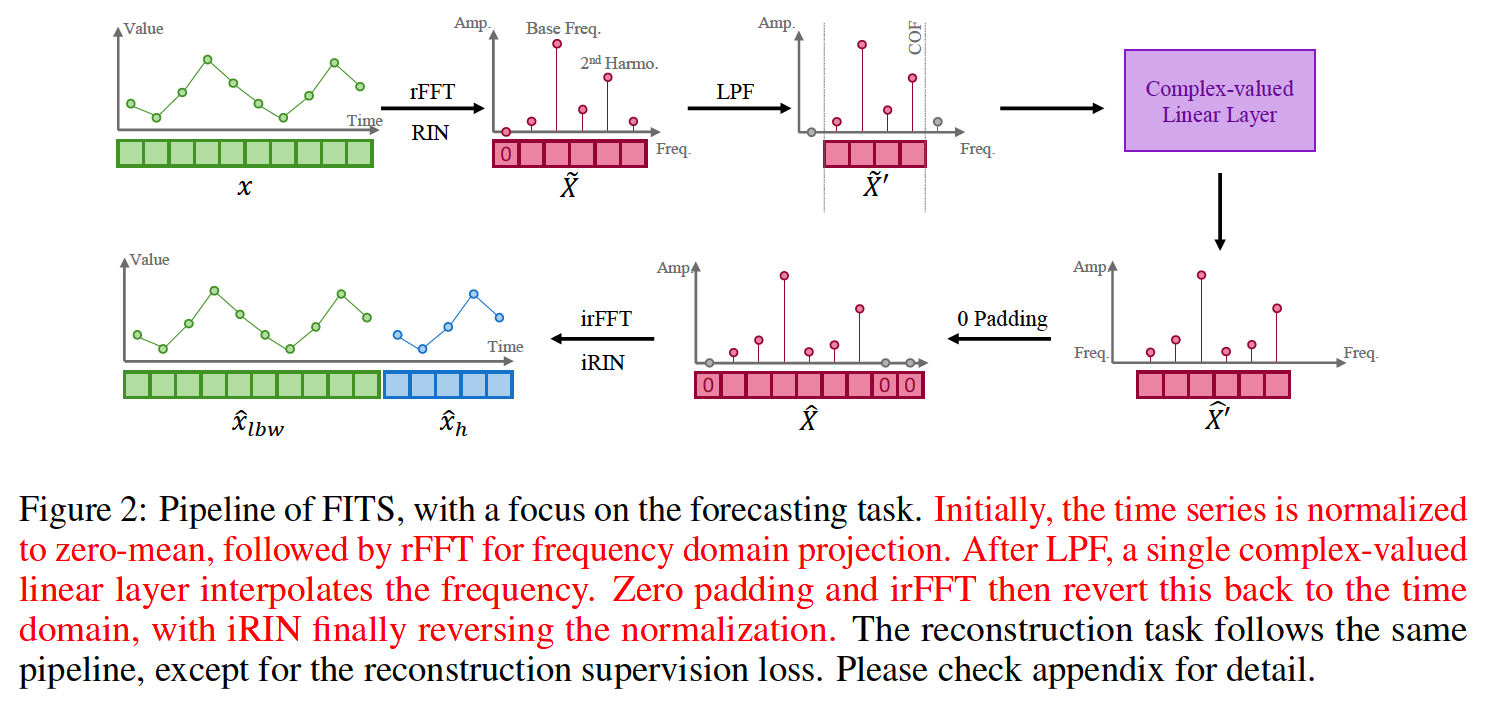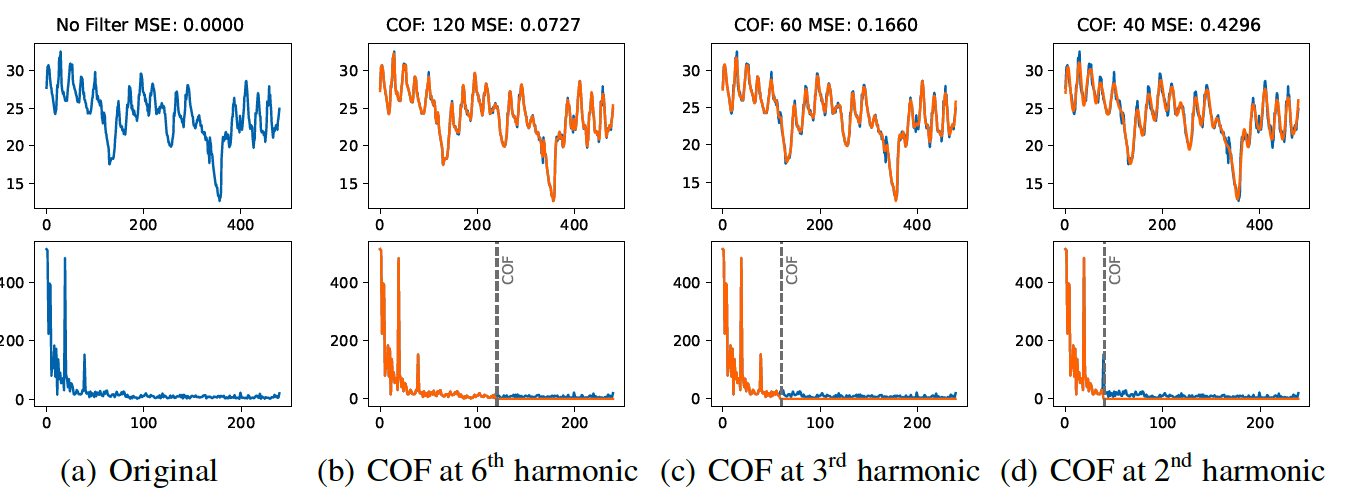FITS: Modeling TS with 10k Parameters
Contents
- Abstract
- Introduction
- Related Work & Motivation
- Method
- Experiments
Abstract
FITS
- lightweight model
- directly process raw time-domain (X)
-
interpolation in complex frequency domain (O)
- use 10k parameters
1. Introduction
Frequency domain representation in TS: compact & efficient
Existing works: FEDformer, TimesNet
-
Still… comprehensive utilization of frequency domain’s compactness remains unexplored!
( i.e. employing complex numbers )
FITS
- Reinterpret TS tasks (i.e. forecasting, reconstruction) as interpolation within frequency domain
- Produce an extended TS segment by interpolating the frequency representation of a provided segment
- ex) Forecasting: by extending the given look-back window with frequency interpolation
- ex) Reconstruction: by interpolating the frequency representation of its downsampled counterpart
- Core of FITS = complex-valued linear layer
- designed to learn “amplitude scling” & “phase shift”
- But still, fundamentally remains a time-domain model, by integrating rFFT
- (1) transform input into frequency domain using rFFT
- (2) mapped back to time domain
- Incorporates low-pass filter
- ensures a compact representation
- Use only 10k params
2. Related Work & Motivation
(1) Frequency-aware TS Models
- FNet
- FEDFormer
- FiLM
- TimesNet
(2) Divide & Conquer the Frequency Components
Treating the TS as SIGNAL
- Break down into linear combination of sinusoidal components ( w/o info loss )
- each component = unique frequency & initial phase & amplitude
- Forecasting each frequency component: straightforward
- only apply a phase bias to the sinusodial wave ( based on time shift )
- then, linearly combine this shifted waves!
HOWEVER, forecasting each sinusoidal component in TIME domain can be cumbersom!
( \(\because\) sinusoidal components are treated as a sequences of data points )
\(\rightarrow\) Solution: perform it on FREQUENCY domain
3. Method
(1) Preliminaries: FFT & Complex Frequency Domain
a) FFT
-
Efficiently perform DFT on complex number sequences
-
Transforms discrete-time signals from TIME \(\rightarrow\) FREQUENCY
( \(N\) real numbers \(\rightarrow\) \(N/2+1\) complex numbers )
b) Complex Frequency Domain
Complex number
-
captures both amplitude & phase of the component
- can be represented as a complex exponential element with a given amplitude & phase
- \(X(f)= \mid X(f) \mid e^{j \theta(f)}\).
- \(X(f)\) : complex number associated with the frequency component at frequency \(f\)
- \(\mid X(f) \mid\) : amplitude
- \(\theta(f)\) : phase
Complex plane
Complex exponential element can be visualized as …
-
a vector with a length equal to the amplitude and angle equal to the phase
-
\(X(f)= \mid X(f) \mid (\cos \theta(f)+j \sin \theta(f))\).

Time Shift & Phase Shift
Time Shift = Phase Shift in FREQUENCY domain
- by multiplying a unit complex exponential element with the corresponding space ( in FREQ domain )
Shift signal \(x(t)\) forawrd in TIME by \(\tau\) = \(x(t-\tau)\)
\(\rightarrow\) Fourier transform: \(X_\tau(f)=e^{-j 2 \pi f \tau} X(f)= \mid X(f) \mid e^{j(\theta(f)-2 \pi f \tau)}=[\cos (-2 \pi f \tau)+j \sin (-2 \pi f \tau)] X(f)\)
- Amplitude : \(\mid X(f) \mid\)
- Phase \(\theta_\tau(f)=\theta(f)-2 \pi f \tau\)
- linear to the time shift.
(2) FITS Pipeline
(Motivation) Longer TS = Higher frequency resolution
\(\rightarrow\) Train FITS to extend TS segment by interpolating the frequency representation of input TS semgnet

LPF (Low-Pass Filter)
- To reduce the model size
- Eliminates HIGH-frequency components above certain cutoff
Forecasting
-
generate the look-back window along with the horizon
( = combining backcast & forecast )
Reconstruction
- downsample the original TS based on specific downsampling rate
- then, perform frequency interpolation
(3) Key Mechanism of FITS
a) Complex Frequency Linear Interpolation
Interpolation rate: \(\eta\)
- ratio of the model’s output length \(L_o\) to its corresponding input length \(L_i\).
Frequency interpolation
- operates on the normalized complex frequency representation ( = half the length of the original TS )
Interpolation rate can also be applied to the frequency domain
- \(\eta_{f r e q}=\frac{L_o / 2}{L_i / 2}=\frac{L_o}{L_i}=\eta\).
With an arbitrary frequency \(f\) …
- Frequency band \(1 \sim f\) in the original signal is linearly projected to the frequency band \(1 \sim \eta f\) in the output signal.
- Input length of our complex-valued linear layer = \(L\)
- Interpolated output length = \(\eta L\).
b) Low Pass Filter (LPF)
-
To compress the model’s volume
-
By discarding frequency components above a specified cutoff frequency (COF)
-
Ensures that a significant portion of the original time series’ meaningful content is preserved
-
High-frequency components filtered out by the LPF typically comprise noise,!
( = irrelevant for effective time series modeling )
-

Selecting COF? Nontrivial!
\(\rightarrow\) propose method based on the harmonic content of the dominant frequency
Also adopt channel independence
4. Experiments
(1) Forecasting as Frequency Interpolation
Input Length : \(L\) Output Length : \(H\) Combination of look-back window & forecasting horizon : \(L+H\)
Interpolation rate of the forecasting task:
- \(\eta_{\text {Fore }}=1+\frac{H}{L}\).
